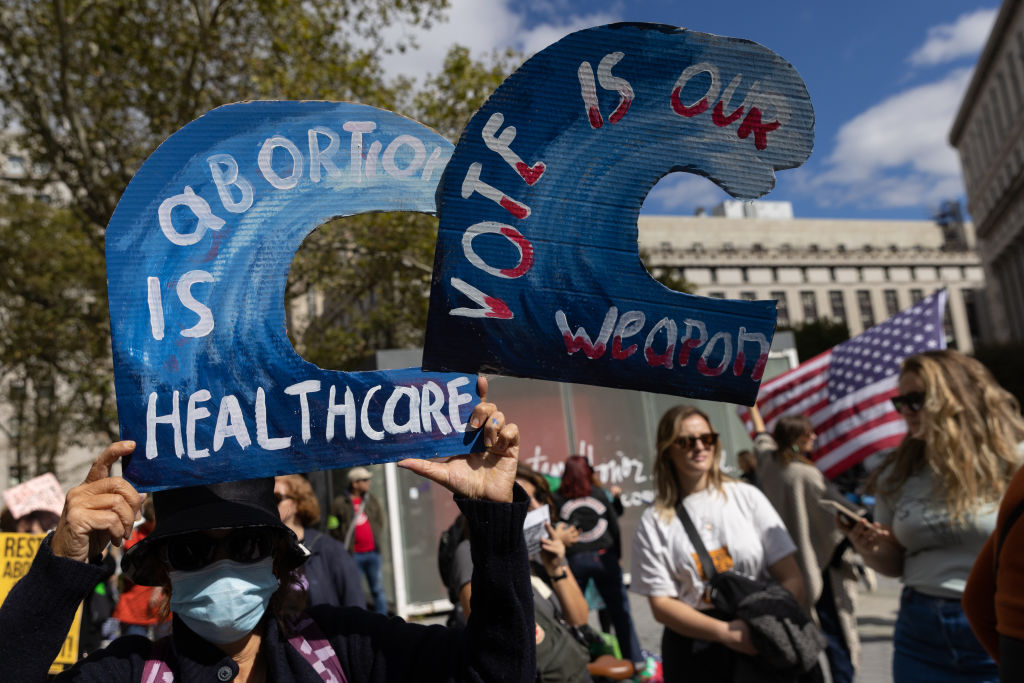A Crucial Year Ahead for Abortion Access
Why legislative decisions will matter more than ever in the second year since Roe was overturned
BY SUSAN RINKUNAS

It has been nearly 18 months since the Supreme Court overturned Roe v. Wade, and the impact of the laws that have come to life since have had devastating consequences for pregnant people. One after another, we’ve read awful stories of patients being rushed to the ICU with sepsis, nearly bleeding out in bathrooms, or having to go out of state for abortions when their fetuses don’t have skulls.
Amid all this news, it can be hard to pinpoint a bright spot, but there is one: Support for abortion has repeatedly won elections. In what would have otherwise been a sleepy off-year of races, voters were so furious about their rights being taken away that they re-elected a Democrat as Governor in Kentucky, codified abortion in Ohio, and flipped a chamber in Virginia, blocking a ban there.
Republicans know their plan to ban abortion in every state is toxic with voters, so they’re trying to deceive people from their end goal. It’s why we’ve seen conservative hand-wringing over the label “pro-life,” attempts to deflect with transphobia, and, yes, even backing away from the word “ban” in favor of “limit” or “minimum standard.”
But, according to Ryan Stitzlein, vice president of political and government relations at Reproductive Freedom for All, voters have shown a sustained fury over the abortion access crisis, and it stands to reason that they’ll keep it up. A major problem, however, is that our democracy isn’t the most democratic, and the majority doesn’t always prevail. (See: 2016.) Amid all the righteous anger, there’s a lurking threat that a Republican president could ban abortion nationwide.
“This is not us being ‘hysterical.’ This is real,” Stitzlein says. “They’re not going to stop until they’ve completely banned abortion.”
As we close out another year of egregious cutbacks to abortion access, here’s what we can expect in 2024.
Abortion policy duked out at the state level
As advocates long warned, the fight for abortion is playing out at the state level and in the courts. There are now 16 states with near-total bans on abortion after laws took effect in Indiana and North Dakota this year, and another four states ban the procedure at 15 weeks of pregnancy or earlier. State lawmakers have the opportunity to block restrictions, pass protections for patients and providers, or even introduce messaging bills on abortion that inform people about threats they face, says Jennifer Driver, senior director of reproductive rights at the State Innovation Exchange (SiX) Action.
Criminalization of providers and patients
In response to threats against telemedicine providers, legislatures in states where abortion is protected are passing “shield laws” to legally protect providers who treat patients across state lines. Still, Driver says those laws are untested as of yet. As for the criminalization of patients, the Nevada legislature could repeal its ban on self-managed abortion, she says—it’s the only state with such a ban left on the books. However, prosecutors can and do weaponize other statutes to criminalize people for behavior during their pregnancy or for pregnancy loss.
Insurance fights
Lawmakers in states like Colorado, New Jersey, and Rhode Island are also doing what they can to expand insurance coverage of abortion, whether through Medicaid or by requiring private insurance plans to cover the procedure without cost-sharing, says Kimya Forouzan, principal policy associate for state issues at the Guttmacher Institute. But it’s not all smooth sailing. In Michigan, one Democrat’s objection to Medicaid coverage effectively ended that effort. Still, the state was able to end the requirement that people with private insurance purchase a separate coverage rider for abortion.
Crisis pregnancy centers
Forouzan says protective states are also moving to regulate anti-abortion crisis pregnancy centers under deceptive advertising statutes, but anti-abortion advocates have sued on First Amendment grounds. Those lawsuits could move their way through the court system in 2024. Conservative states will continue to funnel money and tax credits to CPCs, the vast majority of which offer no legitimate medical care.
Travel bans
In conservative states, the next frontier in the fight against access is restricting travel, Driver says. Idaho passed a law banning people from taking minors out of state for abortions without parental consent, and conservative activists like Jonathan Mitchell and Mark Lee Dickson have been working at the city and county level to try to ban people from driving abortion-seekers on Texas highways to appointments out of state. These attacks seem blatantly unconstitutional, but Forouzan notes that judges don’t need to uphold the ordinances for them to cause harm. “For many people who are trying to access abortion care, hearing that travel is banned or even just vaguely hearing that they could get in trouble or become criminalized for it is enough to dissuade people to not seek care,” she says.
Overlap with anti-trans rhetoric
Forouzan says we can expect to see more politicians connect attacks on abortion access to attacks on gender-affirming care. She cites as examples how Nebraska lawmakers first failed to pass a six-week ban but then later attached a 12-week ban to a bill banning affirming care for transgender youth. And in Ohio, opponents of the ballot measure tried to claim it would protect gender-affirming care.
Local elections and ballot measures
State legislators—who determine the fate of many of these laws—will be up for re-election next fall. Arizona will be a big state to watch that could flip to Democratic control. (The state has a 15-week ban in place, but a Democratic governor.) Driver predicts more candidates for state houses will lean into abortion in their campaigns like they did in Virginia this year. “This was the first time that I had seen candidates actually position themselves against their opponents by saying ‘I am the person that is going to protect access,’” she says. She’ll also be watching to see if conservatives in tough races double down on abortion or backtrack from the issue to try to keep their jobs.
Court appointments will also be crucial: It’s possible access could be fully restored in Wisconsin in 2024, thanks to a Democrat flipping control of the state Supreme Court earlier this year. In Florida, where the Governor appoints state Supreme Court justices, an impending ruling could slash the window of access down from 15 weeks to six—it would be a gigantic blow to the Southeast. There will be many other crucial state races for Governor and Attorney General—electeds who choose whether to sign or veto bills into law and how to enforce them.
And, yes, there are pro-choice ballot measures in the works in about 12 more states for 2024—including in states with active bans—where voters could make a difference. Surely, the victory in Ohio rattled the anti-abortion side: It was the seventh pro-choice victory since the Dobbs decision, and the first affirmative vote in a red state. Already, Ohio lawmakers started scheming ways to weaken it.
Continual erosion of democracy
We could see states use the coming legislative session to try to restrict the citizen-led referendum process by ending it altogether, raising the threshold for passage, or exempting abortion from statewide votes, Driver says. There’s a connection between the erosion of both democracy and abortion rights—bans pass in gerrymandered legislatures. These most recent efforts are “a sign that anti-abortion leaders are really ready to reject the will of the people,” she says.
The national fight to protect access

Stitzlein says ballot measures can be “hugely impactful,” but the threat of a nationwide ban still exists. To fix the abortion crisis in the U.S., there needs to be a federal law protecting access to the procedure. The way to do that, he says, is to re-elect Joe Biden and send him Democratic majorities in the House and Senate. Candidates need to run pro-actively on the message of codifying abortion rights and remind voters in states like Ohio that the work isn’t over.
“Reasonable” Republicans
We’re already seeing GOP presidential candidates shift to a faux-moderate position, and Stitzlein expects it to continue as candidates up and down the ballot try to hide their ultimate goal: banning abortion everywhere. Voters will be hit with a barrage of messaging from Republicans who swear that there won’t be a nationwide ban—either because a ban won’t pass Congress, like Nikki Haley and Ron DeSantis have claimed, or because abortion should be a state issue, as Kari Lake said in a recent reversal of her position. These are, of course, gigantic lies spun out of political desperation. “The fact that you have people like Donald Trump and Kari Lake—of all people—trying to present themselves as moderates on abortion is demonstrative in and of itself of just how toxic this issue is,” Stitzlein says.
Banning abortion without Congress
Contrary to what multiple Republican candidates have said, legislation isn’t the only way a GOP President could ban abortion in 2025. They could simply direct the Department of Justice to enforce the Comstock Act of 1873, a zombie anti-vice law that prohibits mailing items used for abortion. The law is still on the books but wasn’t enforced while Roe stood. Now, conservative groups, including the Heritage Foundation, are urging a potential GOP administration to invoke the law to ban the mailing of abortion pills, though Comstock could be used to end all abortions. So, yes, there’s a world in which Trump wins in 2024, doesn’t have enough Senate votes to pass a law, but can ban abortion regardless.
The impact of Trump judges
If Biden wins but Democrats lose the Senate, it’s unlikely he’d be able to nominate federal judges or fill any potential Supreme Court vacancies. It’s worth repeating that the reason Roe was overturned and we’re facing the threat of a nationwide abortion ban is because Trump appointed three justices in a single term.
A legacy of the Trump administration is packing the court system with far-right activist judges, Stitzlein says, and there’s no more significant example than Judge Matthew Kacsmaryk in Texas. Kacsmaryk ruled in April to revoke FDA approval of the abortion pill mifepristone, and the Supreme Court just decided to hear the case. That lawsuit is another threat flying under the radar, Driver says. “I’m having to remind [state] legislators this case is still happening,” she says. “The everyday person is not following along.” Kacsmaryk is the judge in two other cases, one that could bankrupt a Planned Parenthood affiliate in Texas (and possibly the entire organization), and another that could imperil birth control access for minors at federally-funded clinics. Even if Biden wins, these lawsuits—and all those Trump judges—aren’t going anywhere.
Be mad, stay mad
“We’ve seen this huge surge in turnout every time abortion has been on the ballot, and we expect that to continue to grow in intensity the longer we’re in this crisis,” Stitzlein says. But U.S. voters have a lot of reasons to be mad, including the high cost of living, ongoing wars, and lack of progress on climate action and student loans. There’s still a chance that abortion rage might not be enough to keep authoritarians out of office. After all, Biden only beat Trump in the Electoral College by 44,000 votes in three states. About a year out, it’s not impossible to imagine that vote margin evaporating and the rights of millions of people along with it.

Susan Rinkunas is a reporter covering abortion, reproductive health, and politics. Her work has appeared in Jezebel, The Guardian, Slate, NBC News, Elle, and more.